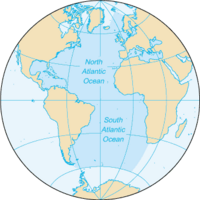
Photo from wikipedia
The regional variability of wintertime marine cold air outbreaks (CAOs) in the northeastern North Atlantic is studied focusing on the role of weather regimes in modulating the large-scale circulation. Each… Click to show full abstract
The regional variability of wintertime marine cold air outbreaks (CAOs) in the northeastern North Atlantic is studied focusing on the role of weather regimes in modulating the large-scale circulation. Each regime is characterized by a typical CAO frequency anomaly pattern and a corresponding imprint in air-sea heat fluxes. Cyclonically dominated regimes, Greenland blocking and the Atlantic ridge regime are found to provide favorable conditions for CAO formation in at least one major sea of the study region; CAO occurrence is suppressed, however, by blocked regimes whose associated anticyclones are centered over northern Europe (European / Scandinavian blocking). Kinematic trajectories reveal that strength and location of the storm tracks are closely linked to the pathways of CAO air masses and, thus, CAO occurrence. Finally, CAO frequencies are also linked to the strength of the stratospheric polar vortex, which is understood in terms of associated variations in the frequency of weather regimes. Plain Language Summary Marine cold air outbreaks (CAOs) bring about adverse weather and lead to intense cooling of the ocean surface. This cooling plays an especially important role in the Nordic Seas, where dense waters are formed that feed into the Atlantic meridional overturning circulation. Variations in the occurrence of such CAOs, therefore, are of fundamental importance in the coupled atmosphere-ocean climate system. In this study, we link persistent states of the large-scale atmospheric circulation over the North Atlantic to the variability of CAOs in the Nordic Seas and the pathways of associated air masses. Our findings reveal that CAO occurrence is primarily modulated by shifts in location and strength of the storm tracks. Periods with intense storm tracks are particularly favorable for the formation of CAOs, thus, leading to enhanced heat loss of the ocean. In contrast, periods dominated by blocking anticyclones tend to suppress CAO formation, unless the anticyclone is located over Greenland. An important implication of our findings is that winters with an especially weak stratospheric polar vortex, which are accompanied by less active storm tracks and more blocking anticyclones, CAOs, are less frequent and heat loss of the ocean is reduced.
Journal Title: Geophysical Research Letters
Year Published: 2018
Link to full text (if available)
Share on Social Media: Sign Up to like & get
recommendations!